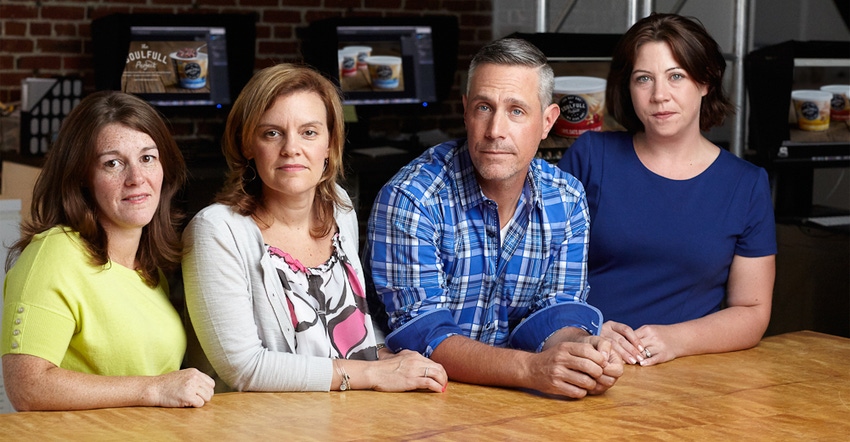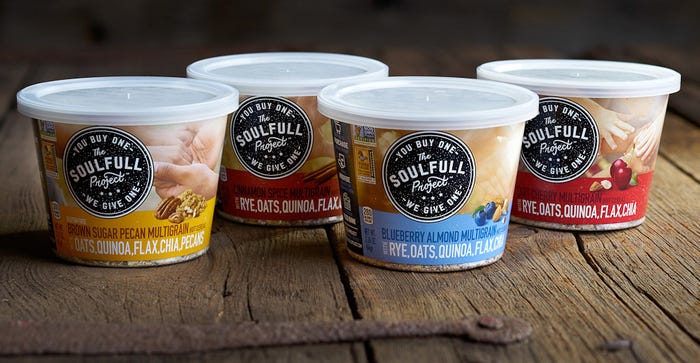The Soulfull Project, a wholly owned subsidiary of Campbell's, is a public benefit corporation built on a buy-one-give-one model.

While much of Big Food’s growth and innovation is coming through the acquisition of smaller, mission-based brands, this new company and its parent company have a different story to tell.
It starts with four colleagues who were working on innovation initiatives at Campbell Soup Company. In their work, they saw firsthand how low-income families were struggling to put food on the table—and how the food those families could afford was making them sick. So they vowed to do something about it.
Megan Shea, Chip Heim, Maria Gamble and Lisa Schipsi quietly assembled and created The Soulfull Project—now its own public benefit corporation funded by Campbell’s—based on a buy-one-give-one model that empowers shoppers to do good in their communities. Consumers buy their non-GMO hot cereal cups, and the company donates a serving of hot cereal to a local food bank.
Cofounder and head of business and operations Megan Shea shared The Soulfull Project's mission with us.
Can you share how you all came up with the idea for the Soulfull Project?
Megan Shea: The project came out of personal experiences that we had, individually and together, meeting low-income families struggling to put food on the table, and then the food they were able to afford was making them sick, and they knew it. They watch Dr. Oz and knew about ingredients like kale and quinoa and chia and all of these aspirational ingredients that just felt very out of reach for them. So we made a personal promise to ourselves that we were going to do something more to help them—more than just send them extra food and extra money.
So the mission came before the product?
MS: The mission completely came first. We knew we wanted something that had the giving model and that could help people in our own community and other communities as we expanded. It was about putting a mission and purpose behind your purchases—the belief that you can buy something that you feel really good about for yourself and know that it lives on and helps someone else through a buy-one-give-one business model. What we’re giving [to the food banks] is the same quality food, and that was really important to us because we really wanted to make sure that the people who were struggling were getting really nutrient-dense ingredients.
Why hot cereal? And what kind of nutritional attributes did you focus on when developing the product?
MS: Breakfast is really a pain point for so many people, regardless of how much money or time you have. It informs someone’s whole day—if they make a bad choice at breakfast, a lot of times by 8 a.m. they think the whole day is shot.
We specifically picked these hot cereals because we knew it was a great way to bring whole grains, really nutrient-dense ingredients in, and do it in a clean way. We focused on making sure that it was accessible to all of us. We wanted to use ingredients and flavors that felt very familiar—brown sugar pecan, blueberry almond—and include ingredients that most of us struggle to fit into our lifestyles, like chia, flax and quinoa.

When we developed the product that we actually give, we did that hand-in-hand with our food bank partners. We took the cup SKUs that we had to the food banks, and they told us that for their beneficiaries, they wanted an unflavored and unsweetened version. So we developed the four grains, family size and, hearty grains and seeds varieties with the food banks, making sure that there’s no sugar added, because it’s really important when you think about the prevalence of diabetes with people who are using food banks. We also made sure it could be customized to their liking.
I know you’re in Wegmans now—with this local-focused mission, is there ability (or desire) to scale?
MS: We built it from day one to be scalable. We wanted to start really small to make sure we could deliver on the promises we were making. We picked our giving partners first: the Food Bank of South Jersey, Community Food Bank of New Jersey and Philabundance, and then we picked stores with Wegmans to surround those giving partners. Right now we’re just in 14 stores that line up with regions that our giving partners are in.
We are looking at scaling with Wegmans over the next few months and years, because hunger and food insecurity is unfortunately affecting every community within the U.S.
What is Campbell's role here?
MS: We’re a wholly owned subsidiary. We were working for Campbell’s as a team and as friends, and when we came up with the idea, we worked on it on the side. We took it to the food banks before we even took it to the leadership at Campbell’s. Once we had a product and a business plan, we took it to the leadership team, and they agreed to fund it. We left our roles and are now operating a public benefit company funded by Campbell Soup Company.
I want to talk a little about the public benefit corporation aspect of your business. Why did you go that route?
MS: We chose the public benefit corporation as a constant reminder of our mission. We didn’t want our mission to be diluted as we grew, so by going with public benefit corporation, our mission is part of our corporate charter. Our mission and our business don’t exist without each other. We use it as a promise and a daily reminder to ourselves that we have to make decisions looking at both.
How do you convey your mission to consumers?
MS: We set really small goals for ourselves initially—for instance, we had hoped to have maybe 500 to 1,000 people on Facebook by the end of our first three months, but we’re actually approaching 19,000. As part of living into our mission, we launched the Soulfull 100, which was 100 volunteer events performed by the team in 100 days with our three giving partners. If you can imagine, trying to start a company and volunteer every day, it was pretty overwhelming, but we did it. We were posting about each event, and what it did was allow us to bring our mission front and center. So by going out and volunteering with our giving partners, showing and highlighting the people that make take time to volunteer every day, we saw that the response from consumers all around the country has been overwhelming, because people want to get involved more. There’s this amazing hunger to learn more about organizations and how people are helping others in their communities.
About the Author(s)
You May Also Like




